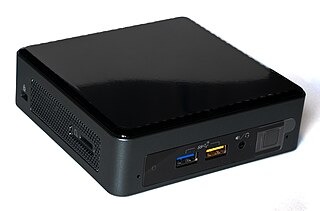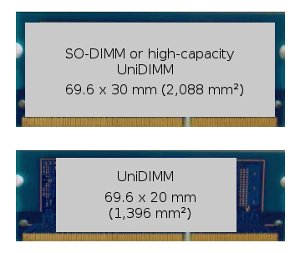
Double Data Rate Synchronous Dynamic Random-Access Memory is a double data rate (DDR) synchronous dynamic random-access memory (SDRAM) class of memory integrated circuits used in computers. DDR SDRAM, also retroactively called DDR1 SDRAM, has been superseded by DDR2 SDRAM, DDR3 SDRAM, DDR4 SDRAM and DDR5 SDRAM. None of its successors are forward or backward compatible with DDR1 SDRAM, meaning DDR2, DDR3, DDR4 and DDR5 memory modules will not work in DDR1-equipped motherboards, and vice versa.

Double Data Rate 2 Synchronous Dynamic Random-Access Memory is a double data rate (DDR) synchronous dynamic random-access memory (SDRAM) interface. It superseded the original DDR SDRAM specification, and was itself superseded by DDR3 SDRAM. DDR2 DIMMs are neither forward compatible with DDR3 nor backward compatible with DDR.

Secure Digital, officially abbreviated as SD, is a proprietary non-volatile flash memory card format developed by the SD Association (SDA) for use in portable devices.
Double Data Rate 3 Synchronous Dynamic Random-Access Memory is a type of synchronous dynamic random-access memory (SDRAM) with a high bandwidth interface, and has been in use since 2007. It is the higher-speed successor to DDR and DDR2 and predecessor to DDR4 synchronous dynamic random-access memory (SDRAM) chips. DDR3 SDRAM is neither forward nor backward compatible with any earlier type of random-access memory (RAM) because of different signaling voltages, timings, and other factors.

Kingston Technology Corporation is an American multinational computer technology corporation that develops, manufactures, sells and supports flash memory products, other computer-related memory products, as well as the HyperX gaming division. Headquartered in Fountain Valley, California, United States, Kingston Technology employs more than 3,000 employees worldwide as of Q1 2016. The company has manufacturing and logistics facilities in the United States, United Kingdom, Ireland, Taiwan, and China.

G.SKILL International Enterprise is a Taiwanese computer hardware manufacturing company. The company's target customers are overclocking computer users. It produces a variety of high-end PC products and is best known for its DRAM products.

JMicron Technology Corporation is a Taiwanese fabless technology design house based in Hsinchu, Taiwan. As a manufacturer of integrated circuits, they produce controller chips for bridge devices.
The P35 Express is a mainstream desktop computer chipset from Intel released in June 2007, although motherboards featuring the chipset were available a month earlier. The P35 Express chipset supports Intel's LGA 775 socket and Core 2 Duo and Quad processors, and is also known to support 45 nm Wolfdale/Yorkfield dual and quad core CPUs. Theoretically, Intel also dropped support for Intel's Pentium 4 and Pentium D processors with this chipset although late Pentium 4 processors, including both the 32-bit-only (5x0) and the 32-bit/64-bit (5x1), and a few others, were fully supported.

TravelMate is a line of business-oriented laptop computers manufactured by Acer. Of the various notebook series Acer has offered, the TravelMate is designated as a lightweight business and professional computer built to withstand day-to-day activities. Travelmate laptops are well received by reviewers, often, however, they are faulted for a lack of visual appeal. The TravelMate name was previously used by Texas Instruments, which sold its mobile computing division to Acer in 1997. The TravelMate mainly competes against business computers such as Dell's Latitude, HP's EliteBook and ProBook, Lenovo's ThinkPad and Toshiba's Portégé.
Double Data Rate 4 Synchronous Dynamic Random-Access Memory is a type of synchronous dynamic random-access memory with a high bandwidth interface.
Golden Emperor International Ltd. or commonly known as GeIL is a manufacturer of computer hardware components, based in Taipei, Taiwan with focus in DRAM and flash based memory products since 1993. Since then, GeIL has been concentrating in memory module design and manufacturing technology. The company employs around 300 people as of Q1 2009 with distribution in 50 countries worldwide. GeIL’s headquarters is located in Taipei, Taiwan, with branches in Hong Kong and China.

LGA 1155, also called Socket H2, is a zero insertion force flip-chip land grid array (LGA) CPU socket designed by Intel for their CPUs based on the Sandy Bridge and Ivy Bridge microarchitectures.

Aspire Timeline is a series of notebook computers manufactured by Acer Inc. designed to achieve battery life in excess of eight hours with ultrathin designs. The first generation Acer Timeline models use Intel's ultra low voltage (ULV) processors and Intel's Laminar Wall Jet technology.
The A Series desktops are part of Lenovo’s ThinkCentre product line. Formerly an IBM brand, Lenovo acquired the ThinkCentre desktop brand following its purchase of IBM’s Personal Computing Division (PCD) in 2005. The first desktop in the A Series was the ThinkCentre A50p. Lenovo has released A Series desktops in multiple form factors, ranging from traditional tower, to small form factor, and all-in-ones (AIOs).
The IdeaCentre K series desktops from Lenovo are described by the manufacturer as being gaming-oriented desktops. Typical features on the desktops include mid-range to high-end processors, discrete graphics cards, multiple hard disk drives, multiple RAM DIMMS, multiple USB ports, and multiple optical disk drives. The K Series desktops also come with a physical switch on the CPU that allows users to shift between different levels of processing power. For example, the K330 offered red for high performance, blue for moderate performance, and green for less processing- and resource-intensive tasks.
Lenovo’s line of Essential desktops is a collection of budget-conscious machines designed for consumers, and advertised as being "affordable, space saving, and energy efficient". The Essential desktop line is different from both Lenovo’s ThinkCentre line and Lenovo’s IdeaCentre line. Lenovo defines its ThinkCentre desktops as business-oriented computers, while the IdeaCentre desktops are meant primarily for entertainment. The Essential range of desktops can be categorized as being between the two – meant more for ordinary everyday use.

Next Unit of Computing (NUC) is a line of small-form-factor barebone computer kits designed by Intel. It was previewed in 2012 and launched in early 2013. The NUC has developed over ten generations, spanning from Sandy Bridge-based Celeron CPUs in the first generation through Ivy Bridge-based Core i3 and i5 CPUs in the second generation to Gemini Lake-based Pentium and Celeron CPUs and Kaby Lake-based Core i3, i5, and i7 CPUs in the seventh and eighth generations. The NUC motherboard usually measures approximately 4 × 4 inches (10 × 10 cm), although some models have had different dimensions.

UniDIMM is a specification for dual in-line memory modules (DIMMs), which are printed circuit boards (PCBs) designed to carry dynamic random-access memory (DRAM) chips. UniDIMMs can be populated with either DDR3 or DDR4 chips, with no support for any additional memory control logic; as a result, the computer's memory controller must support both DDR3 and DDR4 memory standards. The UniDIMM specification was created by Intel for its Skylake microarchitecture, whose integrated memory controller (IMC) supports both DDR3 and DDR4 memory technologies.

ATP Electronics was a manufacturer of NAND based storage DRAM modules founded in Silicon Valley in 1991, headquarter was later moved to Taipei, Taiwan. ATP’s product line consist of Industrial grade products, such as SSD, SD / microSD memory cards, along with DRAM products that are used in business industries across Networking, Enterprise Mobility, Automotive industry, Military, IPC/Embedded Systems, Health care, Gaming and The Internet of Things (IoT). Intel's CMTL, one of the largest third party testing lab for Intel server platforms, only recommended two memory modules companies to purchase motherboards in Taiwan, one noted to be ATP Electronics.

On June 26, 2007, Dell released the new Inspiron desktop series as a replacement to the Dell Dimension desktop computers.













